#david bellmere
Video
A proposal for a sequel to Hidetaka Miyazaki´s masterpiece; Bloodborne.
People that have yet to earn the "childhood´s beginning" ending of said game might have a hard time following.
Continued from the video:
M(other) is the first "other"
Motherhood is one of the core themes the original game revolves around; I wanted to continue to build upon the haunting images that beautiful game hosts. Bloodborne combined fears surrounding the mystery of motherhood, the shady links between females and nightly powers, with the general fear of the unknown, and the other “others” that may lurk within.Aliens are also "others "in the writings of Lovecraft. They are associated with savages and immigrants, with exotic foreign cultures.
Along with their more grandiose, fantastical counterparts, these “aliens” were perceived as a great threat, mainly because of the ideas and viewpoints, the alternative religions they played host to, assaulting the European perspective with their undeniable allure, assaulting Christian values and morality. In a way, Lovecraft was afraid of people different than him because he felt they were valid, and potential agents of mighty, secret, powers. I have to say I much prefer this to the bigotry of low expectations that permeates our culture today.
Dolls are humanity itself. The human body can feel quite "alien" when you look at it under the microscope, or if, instead of a pristine surface of etiquette and makeup, you perceive savage, foreign, beast-like insanity in a fellow homo sapiens, instead of an affirmation of commonly maintained narratives and customs. My version of “the doll” acts as a metaphor for this contrast between simplified, stylized, civilized surface and complex, messy, eldritch innards.
Brief Commentary on each panel:
First picture: The Doll stands triumphant above a recently defeated (and consumed) foe; a lycanthropic inhabitant of the nightmare labyrinth. She appears to have used ectoplasmic fangs to suck out the creature´s blood, in order to feed the developing child within her. Jacques Derrida proposed "language" to be the core of our world (replacing old favorites such as "History" "Man" and "God"). Derrida, as I understand, understood language not to be composed of two different pieces (word and meaning) but rather, word referencing word, in time, one. My pictures are all meant to place pressure on the distinction we make between form and content, inviting people to reflect on that tired old antagonism that, in my opinion, has wrecked enough havoc on our world.
Second picture: The squid-like child repairs her mother´s body from within, using a mold to produce a replacement for some lost body part. Many elements are placed in relation to each other, as a sort of equation. Compare and contrast; Moon, mirror, water, blood, vase, container, broken container, the idea of Aquarius(which is featured prominently in the original game), gaze, inner gaze, mold, wave, darkness, depths, phallic tower, time, Christianity, England, movement, sperm, menstruation, womb, broken body/head etc
Third picture: The Doll sings (or perhaps screams) a magic attack spell, producing a Moon-like light source. She has lent one of her eyes to her child, who stared out into the world; a mundane crystal orb now host to an otherworldly gaze. Two being find blasphemous harmony with each other, to the point where it´s hard to say where one ends and the other begins. Saint Peter´s cross is a symbol I find very beautiful because of how ambiguous it is, and how it exposes the contradictions within Christian morality. The desire to humble yourself becomes the desire to outdo as well, two martyrs in competition, a shadow of a shadow of a shadow.
Fourth picture: A wider view of the previous moment, it brings me great joy to integrate the famous ruins so often seen in the works of Caspar David Friedrich´s works. Sound and light; two kinds of waves, bring destruction down upon a group of would-be rapist/predators. The famous idea that 0.999(etc) equals ONE is referenced. In videogames strings of nines necessarily represent the idea of "maximum" I find that to be very beautiful. Here a mix that concept with the "number or the beast" idea. This picture integrates a variety a Christian elements to produce a decidedly un-Christian vision.
#bloodborne#hidetaka miyazaki#fromsoftware#fromsoft games#doll#hans bellmer#tentacle#lovecraft#fanart#vaatividya#art#horror#satanism#derrida#bloodborne fanart#fan art#victorian#ball jointed doll#caspar david friedrich#saint peter cross
5 notes
·
View notes
Text
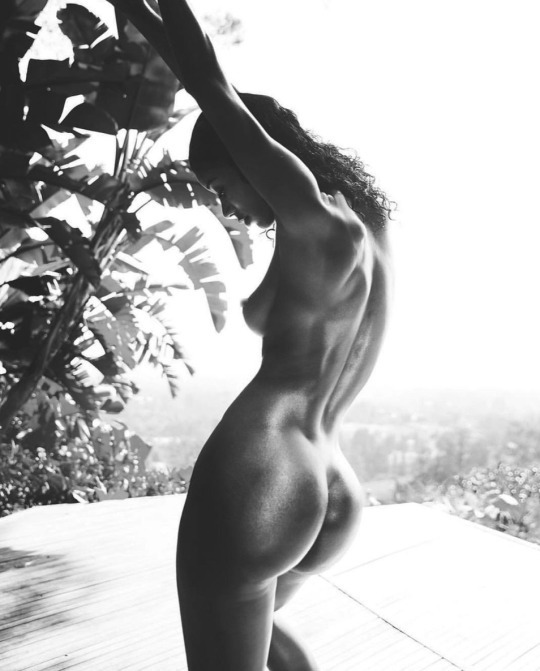
jazzma kendrick by david bellmere
1K notes
·
View notes
Text
Me when someone tags their shitty digital art as hans bellmer and david cronenberg . Digital works will never have the visceral bodily nature of physical work you should probably just draw on paper or work with some other concept :)
#being an ass about this again bc it’s been a while and I can#conceptually they just function In completely different ways and if you don’t take the materiality of substance into account#maybe you’re just not very smart……….#< me saying they function in different ways is me warming up to digital processes btw.#less of a hater now but I still think digital character based work has completely oversaturated my generation of artists#and maybe we should all kill ourselves over it#if you are thoughtful and cool with digital processes then that’s fine I have no problem with you fyi
5 notes
·
View notes
Text
april 20 2024
Setting is a warehouse, concrete, high ceilings, cool lighting, dreary. A stage. A long chain hung from the ceiling, and at the bottom of it, swinging back and forth like a pendulum was my girl cousin's body. It resembled a Hans Bellmer sculpture. Limbless. Meat. Not bloodied or gruesome, and she was alive. On the floor some paces in front of me lay her limbs and head, and a jar of the petroleum jelly-like substance substance used to "seal" "her" into the swinging fleshmass.
I saw/understood that she first attached herself to the chain, then smeared the jelly over her head and limbs one by one, and as each was covered, it sucked into her torso the same way turtles withdraw into their shells. Simultaneously, each appendage would appear on the stage floor, waiting mutely for her to reclaim them.
This was a ritual done for wellbeing. A vacation from the concerns of the mind, concerns of doing, going, of being a person. Sealed inside the ball of flesh, the rhythm of the swinging a comforting metronome. ( For both experiencer and observer )
I stood before the stage, front and center, watching her swing awhile, feeling calm, meditative, hypnotized, curious, mixed with that somewhat queasy feeling I get when I see a stitched up wound, or a lot of blood. Not disgust, but that visceral, edgy sensation. Witnessing her process felt like an act of respect. It had a gravity to it. I was patiently awaiting my turn, playing out in my mind what it would feel like to undergo the transformation. I looked forward to the peace of being headless.
Visual mood: Rick Owens + Francis Bacon + Hans Bellmer + David Lynch
Sounds: Spacious silence other than the occasional sound of copulating chainlinks
Smells: None recalled
1 note
·
View note
Text

VISIONS DE MANDIARGUES
MODERNITÉ, AVANT-GARDE, EXPÉRIENCES
Alexandre Castant, Iwona Tokarska-Castant
Dans Visions de Mandiargues, essai sur André Pieyre de Mandiargues (1909-1991), écrivain, poète, critique d’art, surréaliste de la seconde génération et auteur passionné par l’image dont il a constamment irrigué son écriture, sont d’abord invités les œuvres ou les témoignages de ses contemporains : écrivains (André Breton, Alejandra Pizarnik, William Burroughs), artistes et plasticiens (Leonor Fini, René Magritte, Wifredo Lam), photographes (Hans Bellmer, Henri Cartier-Bresson, Man Ray) ou cinéastes (Michelangelo Antonioni, Walerian Borowczyk, Nelly Kaplan). Mais aussi, au fil de brèves liaisons imaginées et contre toute attente, apparaîtront les citations d’œuvres d’artistes contemporains dont l’univers, à de multiples égards, propose un reflet de son esthétique dans le champ de la peinture et des plasticiens (Claude Lévêque, David Reed, Philip Taaffe), de la photographie (Martine Aballéa, Denis Roche, Hiroshi Sugimoto), de la vidéo (Kenneth Anger, Eija-Liisa Ahtila, Bill Viola), du théâtre (Jan Fabre, Jacques Vincey, Krzysztof Warlikowski) ou du cinéma (David Lynch, Raoul Ruiz, Apichatpong Weerasethakul). Dès lors, fortes de ce nouvel éclairage, des thématiques telles que l’œuvre de Marcel Duchamp ou le baroque, l’art des jardins ou la sémiologie, l’érotisme ou la plasticité des images mentales, la notion de genre ou celle de livre d’artiste composent Visions de Mandiargues pour approcher l’incandescente modernité de son écriture : son expérience au xxie siècle. Enfin, des photographies, respectivement de Bernard Plossu, Bona Pieyre de Mandiargues, Florence Chevallier, Érik Bullot, Gérard Macé, Nicolas Comment, Sara Imloul, Kourtney Roy, Muriel Pic et Françoise Nuñez, ouvrent chaque chapitre de Visions de Mandiargues comme une invitation de l’image à l’écriture qui pourrait en être l’écho.
A. C. & I. T.-C.
filigranes.com
5 notes
·
View notes
Text
The Uncanny
The Uncanny as a term arose in 1919 as the title of Sigmund Freud’s essay exploring the junction between aesthetics and psychology. The writings explored the uncomfortable within the familiar, the blurred line that exists between the homely and human and the unnerving and alien. Some examples would include the doppelgänger, automaton, waxwork doll and mannequin, corpse and body-parts. Mirrors, abandoned houses and graveyards also are borderlands that could be considered uncanny. As a concept in art and pop culture, the idea of the uncanny has been used by writers, artists, sculptors, photographers and film makers for decades.
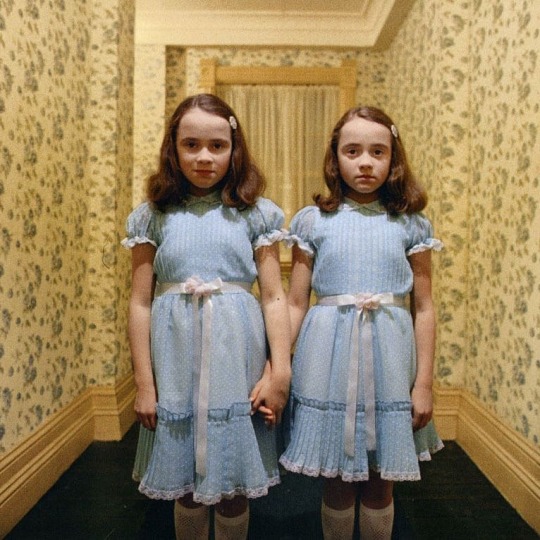
The Grady Twins, from Stanley Kubrick’s The Shining (1980), by Stephen King.

Laura Palmer’s doppelganger in Twin Peaks by Mark Frost and David Lynch, 1990.
The concept has also entered into science through the work of leading roboticist, Masahiro Mori, author of a 1970 paper titled The Uncanny Valley. The paper described that while increasing level of human likeness achieved in a humanoid robot’s design initially results in increasing our affinity towards it, this response is finite. Mori had recognised that at a certain level of human likeness, an android’s appearance becomes creepy and weird, resulting in a rapid drop off in affinity, termed Uncanny Valley. Although it was conceived in robot design, the graph is thought to apply to any design with a human likeness, from dolls to CGI characters.
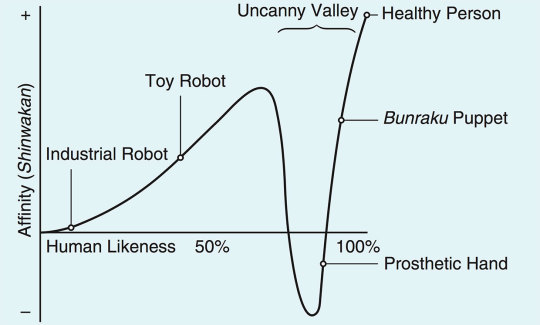
The Uncanny Valley, Masahiro Mori, 1970.
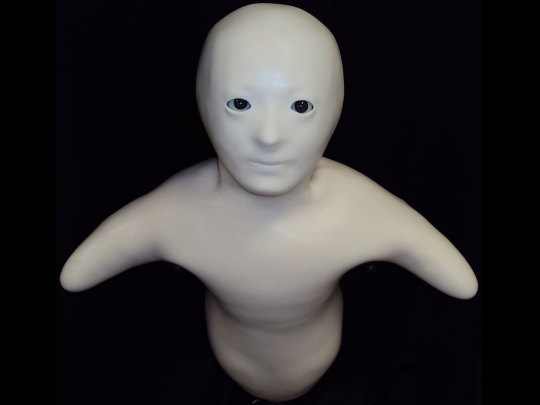
Telenoid, an uncanny robotic communication device designed by Japanese roboticist Hiroshi Ishiguro.
Some key artists working in the uncanny:

Claude Cahun, Que me veux tu? 1929.

Hans Bellmer, (1902-1975), The Doll, c.1936.

William Eggleston, Sumner, Mississippi, c. 1969-70.

Lucas Samaras, Photo-Transformation, 1974.

Francesca Woodman (1958–1981), Untitled, from Angel Series, Rome, Italy 1977.

Cindy Sherman, Untitled #153, 1985.
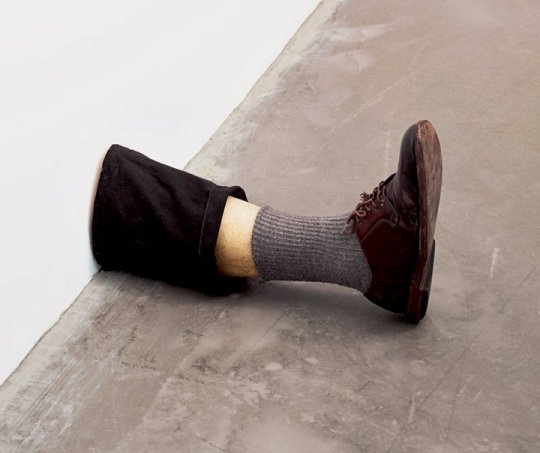
Robert Gober, Leg, 1989.
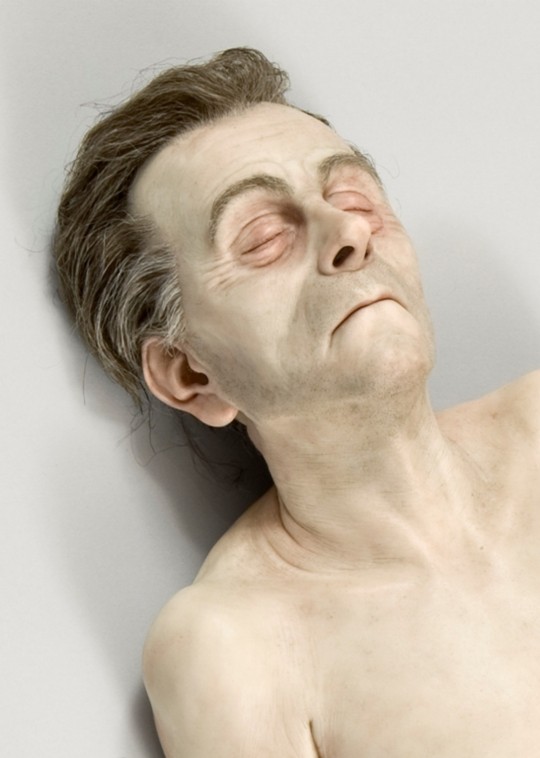
Ron Mueck, Dead Dad (detail) 1996-7.

Mona Hatoum, Grater Divide, 2002.
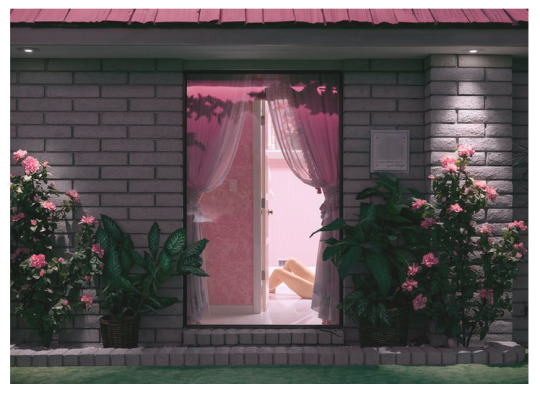
Juno Calypso, A Cure For Death, 2018.
4 notes
·
View notes
Text
“ In the prologue of Gary Shipley’s 2017 novel Warewolff! , the narrator states that he began to hear “one thing’s voice, and from that voice a portrait of itself—of itself made up with other things. It was learning to talk by shaping the stories of its victims.” Later on, the radically alien narrator describes the world he encounters: “Just stuff that isn’t me. And I do not feel like stuff. I feel like this endless faceless seeing. I’m a seamless tracking shot without arms or legs. It’s like I’m blind or have locked-in syndrome when I don’t.” David Roden compares Shipley’s work to Hans Bellmer’s anagrammatic dolls, because :
both have no axioms or rules beyond the hazards of its dispersal. It is its own entirely misleading portrait. It has no people or worlds, only disjointed clones, plucky carcasses and scripts we mistook as our lives. Yet despite this ontological poverty, we can read Warewolff! Something happens, even if we do not understand what. Its dispersal is the horror of biomorphism: a condition somewhat akin to life that, like Shipley’s alien, “discloses its arrangements” through our language centers. And this is the condition of unbinding: we are spoken by something; we pass into something without even the assurance that our hunger is our own.
The Thing does not just come from another world, but from another time: pre-human time, well before“shared time life regression” became a possibility. It does not speak to us. It’s not speaking us. Our hunger is dismissed. The Thing is a transduction mechanism, a system for translating itself into itself across different language-forms, impelled by an ananthropic rather than inhuman drive. The inhuman or posthuman are necessarily defined from human existence; they’re translations from the human into some otherness. Their hyperplasticity is a quantitative increase in plastic force. But The Thing does not actually care about humanity, technology or intelligence. Intelligence becomes completely irrelevant when it freely navigates through living forms, encountering cognition as just another edible formal feature. Purely immanentized “living”, it dismisses thinking because “thinking has interests that do not coincide with those of living; indeed, they can and have been pitted against the latter”. It is what Meillassoux would define as a “contradictory entity”, which
is always-already whatever it is not: /…/ the introduction of a contradictory entity into being would result in the implosion of the very idea of determination—of being such and such, of being this rather than that. Such an entity would be tantamount to a “black hole of differences”, into which all alterity would be irremediably swallowed up, since the being-other of this entity would be obliged, simply by virtue of being other than it, not to be ot her than it.
Accordingly, real contradiction can in no way be identified with the thesis of universal becoming, for in becoming, things must be this, then other than this; they are, then they are not. This does not involve any contradiction, since the entity is never simultaneously this and its opposite, existent and non-existent. A really illogical entity consists rather in the systematic destruction of the minimal conditions for all becoming—it suppresses the dimension of alterity required for the deployment of any process whatsoever, liquidating it in the formless being which must always already be what it is not.
Aesthetic metaplasticity is evil aesthetics: it is the appropriation of any empty anthropological form to hide the inhuman amorphousness, the reformulation of the cogito “less in terms of an I think and more in terms of an It lives”. As Mark Fisher concedes, “it has seemed as if the deterritorializing impulses of capitalism have been confined to finance, leaving culture presided over by the forces of reterritorialization”. Metaplastic works, such as those by Gary Shipley, Kenji Siratori, Jake Reber and Mike Corrao, explore cultural deterritorialization through contingent abstraction. They’re made of entities which are not only hyperplastic—able to transform themselves into anything existent—but metaplastic: able to morph into anything non-existent, or to counter-morph anything existent. They’re full of bodies that, rather than anticipate an age of cyborgs, enhanced humanoids and intelligent machines, “announce the end of being”, full of “objects that announce the end of meaning”, of “elements that whorl each of their parts containing the end of the cosmos”. In those artworks we find “something akin to Time, but a Time that is inconceivable for physics, since it is capable of destroying, without cause or reason, every physical law, just as it is inconceivable for metaphysics, since it is capable of destroying every determinate entity, even a god, even God /…/ It is a Time capable of destroying even becoming itself by bringing forth, perhaps forever, fixity, stasis, and death.”
-
GERMÁN SIERRA - Metaplasticity - Šum12
#GERMÁN SIERRA#David Roden#Metaplasticity#Šum12#Mark Fisher#Capitalism#s. And this is the condition of unbinding: we are spoken by something; we pass into something without even the assurance that our hunger is
13 notes
·
View notes
Photo

© Nadia Lee Cohen (British, born 1991)
She’s my fav photographer, the weird, unexpected mixture between Alfred Hitchcock, Martin Parr, Otto Dix, Quentin Tarantino, David LaChapelle, Helmut Newton, Max Ernst, René Magritte, David Hockney, Cindy Sherman, Roy Lichtenstein, Hans Bellmer, Hanna-Barbera, Lorena Bobbit, Stanley Kubrick, Louise Bourgeois, James Ensor and and and
#nadia lee cohen#lee cohen#cohen#photography#contemporary photography#fashion#miu miu#miumiu#young artist#young photographer#british photographer#nadialee#nadia lee
2 notes
·
View notes
Note
What are your favorite characters?
Hey!
So, starting with the fandoms I recently hopped back into (without stopping loving the characters): DC and Miraculous. For DC I have, like, the whole Batfam + Alfred, Commissioner Gordon, Jon Kent, Supergirl, WINN, Barry Allen, AQUAMAN (boy he’s amazing!!!!), Catwoman and Harley (Harely is my baby and deserves the world after what Joker did). For Mirculous it’s easy, I have four in total, and those are Marinette, Plagg, Chloè and Felix.
Then, hopping on other fandoms. Let’s start with Marvel and Doctor Who. For Doctor Who there’s my girl Rose, and Eleventh. I just adore Eleventh, he’s an uncoordinated housecat and I love it (quoting the meme) and obv Jack Harkness and also Rory (poor boy is the perfect bf). Then, for Marvel. Oh boy, this will be long, and without explaining why I love them. My holy trinity of Marvel characters are Black Widow, Spiderman (Peter Parker) and Shadow Girl. But I have so many favs that it borders ridiculous: other than them, there’s Miles Morales, Gwen Stacy (i prefer her to MJ), Tony Stark and Pepper Potts, Hawkeye (deaf circus baby, i love him), Fury, MAY PARKER (listen the woman raised her nephew all alone she’s been his mother supported him through everything I stan one(1) queen), Iceman, Quicksilver (both Avengers one and X-Men one), Peggy Freacking Carter who deserved better (I stan), Storm, Rhodey, Gamora, Thor and Loki, Hope Van Dyne and Kurt Wagner (aka my blue baby), with honourable mention of Scott Lang, Deadpool, and Moon Knight.
Then, on with the next two fandoms: TUA and Magi. For TUA it’s easy peasy lemon squeezy: Diego, Klaus, Numebr Five, Ben and Vanya. Honourable mention of Dave. Magi, oh my good sir Magi. Magi will be the death of me basically each character is my love, my child, my baby to be protected. Name one character and be sure it’ll be on my list. Apart for Sinbad, David, Arba, Spartos and Hinahoho (i could never stand the latter two even if they’re good people. Dunno why).
Then, on we go: FMA and One Piece: FMA. I have two words: Team Mustang. And a few other people, namely Ling Yao, Maria Ros and Maes Hughes. One Piece is a bit more people, My holy trinity is Nami, Rufy and Makino. But there’s also Shanks, Zoro, Chopper, BROOK, Ace (I’m still not over him tbh), Dragon, Garp, Smoker and Tashigi, Cora-san (also still not over him), Law and Bellmere (and definitely still not over her).
Then there’s Total Drama, Bleach and Deltora Quest. Total Drama is only Gwen and Chef. Deltora Quest is only Jasmine. And Bleach... Bleach there are a few, starting with my Holy Trinity/fam: Toshiro Hitsugaya, Rangiku Matsumoto and Gin Ichimaru (am I crying over Gin’s death and my sunken fam hcs? Yes, yes I am.). Then there’s Ichigo, Tatsuki, Rukia, Byakuya, Urahara, Yoruichi, SHINJI my man. Is that Isshin’s name I’m hearing in the distance? Damn sure it is! Isshin is a good dad, and he’s adorkable but badass. Sort of like Sups and Bats.
Then BNHA, Detective Conan, GOT and Huntik: BNHA it’s literally 7 people: Todoroki, Momo, Aizawa, Ms. Joke, Shinso, Hawks and Fuyumi. For Detective Conan is 5 people: Shinichi himself, Kaito Kid (he improvises 90% of the time and I love it), Masumi Sera, Shuichi Akai and Eri Kisaki (a lovely woman who will demolish you in court). GOT I love and adore Arya, my boy Gendry and Tyrion Lannister. Huntik. Huntik is my childhood and though I see perfectly how much flawed she is, I love Sophie. Lok is a puppy and a son I must protect, then Dante and Zhalia are my babies too, and don’t we forget my love Montehue and his axe.
Do I really have to go on? Because I don’t want to stay here all night listing my favs... I can go with some of the other many many fandoms, but more than this it’s quite frankly too much lol
#me#blacky answers#my fav characters#there are too many#you can't just come and ask me to list them all#they're too many#really girl#they're so many
2 notes
·
View notes
Photo
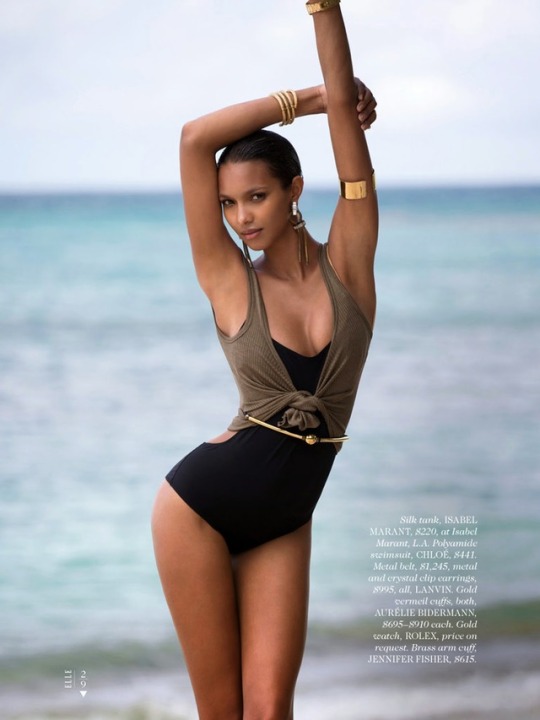
Lais Ribero for Elle US June 2014 photographed by David Bellmere
40 notes
·
View notes
Text


Hey Guys,
Sharing with you the work of David Bellmere.I am being following his work since a long time! But got a chance to study his work deeply.
David Bellmere is Paris, France based photographer.
His work has been credited as striking the perfect balance between sensuality and elegance in his images.
In February 2018, Bellemere was one among several photographers accused of sexual misconduct by professionals in the fashion industry.
The main thing I like about his photographs is he always uses natural light and the way he makes his models comfortable! He has his personal series called as nude! You can find the documentry for the same on Amazon prime!
Here is the link to work of David Bellmere :
https://art-dept.com/photography/david-bellemere-preview/4901/
Here is the link to David Bellmere’s Documentry :
https://www.amazon.com/gp/video/detail/B076MJN9Q5
1 note
·
View note
Text
artist models for this term
painting
- Oscar Murillo
- David hockney
- Brian harte
- Urszula Gogol
-
photo
- Ana mendieta
- Hans Bellmer
- Unica Zürn
0 notes
Text
Nadav Kander - The Meeting
210220
Nadav Kander (Born 1961) is the first photographer that I cite in conversation about which practitioner has influenced me the most. He was born in Tel Aviv and based in London, although he does not regard himself to be British. His photographs are a part of the collections at the National Portrait Gallery and Victoria and Albert Museum.
Kander began taking pictures at 13 years old with a Pentax camera. In the South African Air Force, he processed film and printed aerial photographs. In 1986, he moved to London where he currently resides with his wife and three children. Portraiture and landscape photography are the main genres that he is best known. I have an appreciation for the consistency in his career, which has traversed 30 years across fine art and commercial platforms. He has photographed celebrities, models and a multitude of other sitters. In 2009, his 52 portraits published in The New York Times Magazine portrayed President Barack Obama and his closest associates. It is the largest portfolio of work that the publication has ever showcased. Later that year, Kander was awarded the prestigious Prix Pictet Earth for Yangtze - The Long River (2008). The shortlist of nominees included Ed Kashi, Andreas Gursky and Naoya Hatakeyama. The list of his other awards is extensive and includes a World Press Photo Award 2013 and 2014, Honorary Fellowship from The Royal Photographic Society 2015 and Outstanding Contribution to Photography from Sony World Photography 2019. (Lens Culture, 2020)
During the World Press Photo Exhibition 2014 at the Southbank Centre, London, I was particularly taken by Kander’s 3rd Prize entry of actor Chiwetel Ejiofor. The photograph first appeared in New York Magazine as a staged portrait to commemorate the British actor. Ejiofor, played a black man kidnapped in 19th Century America and sold into the slave trade in the film 12 Years a Slave (2013). He received an Oscar nomination for the role and won Best Actor at the BAFTA awards. Actors have a trained ability to respond to a camera. He appears poised yet relaxed. Kander’s characteristic turquoise key light is apparent with a red back light to highlight the outline of the sitter. The lack of a fill light leaves a proportionate amount of this face in an enigmatic shadow. This low-key lighting design gives the photograph a sombre tone. Emphasis is placed upon Ejiofor’s eyes, which reveals the complexity of his role in the film. As a viewer of the work in person, I felt a closer affinity to the subject when it was close to life sized. Its considered forms had a significant presence akin to a drawing, painting or sculpture. (World Press Photo, 2020)
The Meeting (2019) is a book that acts as a homage to Kander’s career, with photography from his early foray into the genre to illustrious works recognised within the fine art and academic communities. The annotations add insightful anecdotes about each piece and the man himself. The opening, entitled ‘The Triangle’ outlines a relationship of personal interest to me between sitter, photographer and viewer.
‘I don’t photograph to tell stories. I photograph to make stories. The viewer, if they hold their gaze long enough, becomes the author of the work’s meaning.
Consider there’s a metaphorical suitcase packed with white, grey and darker clothing that we carry around with us wherever we go. When we meet someone, we choose what items to show; maybe only clean white shirts, perhaps darker one. This unpacking is symbolic of a meeting. Much like when I work with a sitter. Our stories collide and change depending on the day, the weather, our emotional states.
If I manage to make a portrait that stirs a viewer then they complete what I call ‘The Triangle’ by bringing their own story or state of mind to the picture. This is fundamental to me, but often missed or misunderstood, because photography is still considered by many to be a record of an event. It is that; but it is not only that. How can it be?
Perhaps if we replace the word ‘photographer’ with ‘poet’ the point becomes clear. It is accepted wisdom when it comes to poetry that every individual reader finds his or her own meaning in the poem and this perspective is unique - no more less valid that yours or mine. The same, in my view, is true of photography.’
In email correspondence between 4th and 28th April 2019 with David Campany, Kander describes his photographic process. These extracts resonated with me as a practitioner of portraiture and landscape photography.
NK - I’ve walked down one road since I started photographing when I was 13. I feel I haven’t deviated at all. I still need my work to strike the same chords in me that I’ve always longed and striven for. My photographs (however varied a viewer might find them) come from the same inner place. I seem to revisit a slowed-down reality, which is very beautiful and important to me. Slow, quiet and slightly uneasy, alluding to more going on beneath what you first see. The subconscious need to express what feels meaningful and profound never goes away. I just try many ways to revisit it, to come at it from different directions.
DC - The portraits you’ve made seem to have quite a special place in your work. As if a face, or a person, is a way to get to the tension between surface and depth. I feel the human face is somehow already an image before it’s photographed. It’s already a kind of presentation, or representation of the self, although a very fragile and elusive one.
NK - That is beautifully put! Yes, my photographs of people are an essential part of my practice.
They follow on from my photographing landscape. When first dealing with landscape I realised it wasn’t the natural environment I was after, but the man-altered landscape. I focused on a darker nature, our destructive ambivalence to our surroundings, but I shrouded these scenes in beauty using compositions that, purely from their form, colour and weight, would have an effect on me apart from the information shown.
DC - Portraiture is often thought of as a two-way exchange, between photographer and sitter, but you’ve talked often of the viewer being crucial to meaning. That said, there’s a real intimacy to your portraits, as if these people have been given the freedom to forget their audience momentarily. We viewers can look, without feeling we’re being performed to. Is this how it is?
NK - I’ve had to think a long time about your question. Much of what I do is intuitive so finding the words is difficult. When I’m in front of a person (or a landscape for that matter), there’s nothing in my head that matters. I’m just looking with so much concentration that sometimes it feels as if I might explode. I do not want to be stirred so badly! All I want is for something to show itself, something that if I release the shutter will become an image that will stir me and unsettle me. To get close to this I must direct people very softly, subtly, and create the appropriate light so that they experience something of themselves. Any frivolous act for the viewer will never work; it would appear transparent. It has to be just for them and me. Only once this is successful does the viewer enter and make up the triangle. Artist, subject and viewer - each one a part of the whole.
From beneath the surface beauty, comes an existential call that touches on questions of destiny and the unknown. The works of Hans Bellmer, Man Ray, Raoul Hausmann, Dalí and Hans (Jean) Arp have also had a big influence on me. Although my work is not surreal, the feeling I get from the work of these artists is something I always search for. For example Jean Arp’s sculptures were very informative when I began photographing the nudes that became the series ‘Bodies - 6 Women, 1 Man’.
DC - It’s interesting that you put it that way. Very often I find myself wondering what landscapes your sitters were in just before they came to you, what it was - out there in the world - that is on their mind as you make the photograph.
NK - A portrait is one way of looking at some facets of our condition. There’s a precious and beautiful flicker of understanding, or the opposite, that shows itself for short periods and disappears. These periods, which I must see and try to photograph, are often responses to the light or the atmosphere that the light imbues. I must try to recognise them as an image that has what I love; depth of feeling, vulnerability and poise, pride and soul, a recognition of something more than just this moment now. Little of this clear to me, but this is the best I can do to explain it. (Kander, 2020)
Summary
It is an inevitability that a photographer emulates their heroes. Whenever I read that someone like Kander also had starting points for their practice, I am encouraged. I have covered in detail the practitioners that have inspired me for this project - Smith, Andrew, Refn, Sigel and Norwood. There are blog posts committed to each of them. However, I felt that Kander required more substantial meditation. There are parallels between his voice and my own - low key lighting and moody colour saturation delivered with a quiet temperament. He reveals that these attributes are the reflection of triangles that he forms between himself, his sitter and viewer. A sitter may choose to present themselves in any number of ways to his lens then this narrative is open for further interpretation by anyone that encounters his imagery. During his interview with Campany, he explains that he implements soft direction, free of frivolity to search for each photograph. He also explains a slow and quietened reality that he occupies beneath the surface appearance of what he sees.
The Ejiofor portrait inspired me during a formative stage of my photography. There is overlap with the other photographers and cinematographers that I have mentioned. Low key lighting is a continuous theme; however, Kander’s renderings have more depth. He is reluctant for media attention and I found The Meeting (2019) to be highly enlightening. His is the work of a ‘poet’ acting as a ‘photographer’, to use his own metaphor. As an analytical student, I have attempted to dissect what makes Kander, Kander. An awareness of his process is just the beginning. My lighting will resemble his, in addition my direction style is already collaborative instead of dictatorial. Any additional intricacies are unique to his voice. As I develop as a photographer myself, I am hopeful to have as reputable career and recognition. There are plenty more triangles that I am eager to construct.
Bibliography
Kander, N. (2019). The Meeting. London: Steidl
Lens Culture (2020). Biography. Lens Culture. Available from
www.lensculture.com/nadav-kander
[Accessed 10/04/2020]
World Press Photo (2020). 2014 Photo Contest. World Press Photo. Available from
www.worldpressphoto.org/collection/photo/2014/29789/1/2014-Nadav-Kander-PS3
[Accessed 10/04/2020]
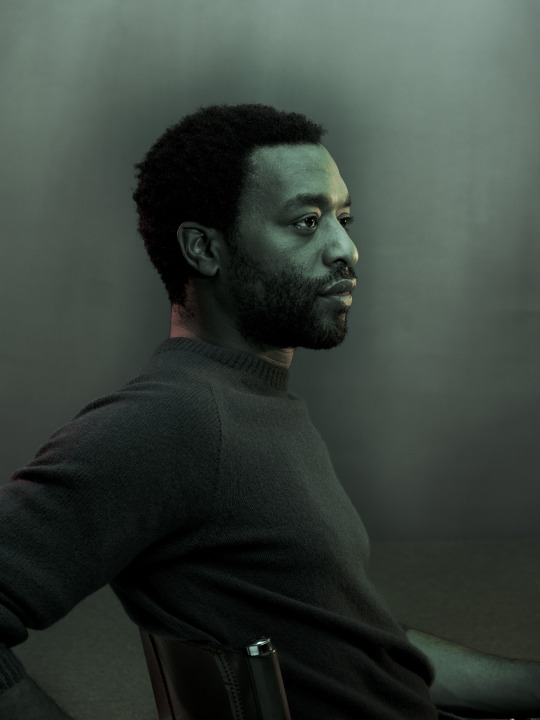
Nadav Kander, Chiwetel Ejiofor, 2014
0 notes
Photo

List of artists who have participated in exhibitions at 356 Mission:
2013
Laura Owens
Math Bass
Mike Bouchet
Sarah Braman
Sara Clendening
Barry Johnston
Kricket Lane
Daniel McDonald
Pentti Monkkonen
Matt Paweski
Jennifer Rochlin
Colin Snapp
Jessica Stockholder
Oscar Tuazon
Daniel Turner
Amy Yao
Eric Palgon
Yshai Yudekovitz
Nicholas Arehart
Bridget Batch + Kevin Cooley
Danielle Bustillo
Joey Cannizzaro
Jamie Hilder
Meghan Gordon
Becca Lieb
Mindy Lu
David Sikander Muenzer
Bryne Rasmussen-Smith + Andrew Smith-Rasmussen
Tatiana Vahan
Sturtevant
Shimon Minamikawa
2014
John Kaufman
Scott Reeder
Oliver Payne
Yuki Kimura
Alex Katz
Michael Dopp, Calvin Marcus, and Isaac Resnikoff
Trevor Shimizu
Becca Albee
Brody Albert and Kaeleen Wescoat-O'Neill
Lilly Aldriedge
Katie Aliprando
Mark Allen
Dewey Ambrosino
Marie Angeletti
Eika Aoshima
Jonathan Apgar
Cory Arcangel
Jacinto Astiazaran
Lisa Anne Auerbach
John Baldessari
Judie Bamber
Ray Anthony Barrett
Peter Barrickman
Darcy Bartoletti
Math Bass
Stephen Berens
Jennifer Berger
Molly Berman
Cindy Bernard
Amy Bessone
Lucas Blalock
Seth Bogart
Jennifer Bolande
Joseph Bolstad
Elba Bondaroff
Marco Braunschweiler
Brian Bress
Brian Briggs and Laura Copelin
Delia Brown
Sally Bruno
Edgar Bryan
Elizabeth Bryant
Jedediah Caesar
Jedediah Caesar and Kate Costello (Extraterrestrial)
Sarah Cain
Kristin Calabrese
Ingrid Calame
Ross Caliendo
Joshua Callaghan
Brian Calvin
Andrew Cannon
Ben Carlson
Jae Choi
Milano Chow
Donna Chung
Jonathan Clarke
Sara Clendening
Justin Cole
Kelly Marie Conder
Matt Connors
Vanessa Conte
Alika Cooper
Liz Craft
Meg Cranston
Cameron Crone
CH Cummings
Lila De Magalheas
Dave Deany
Michael Decker
Gracie DeVito
Michael Dopp
Katie Douglass
Lauren Dudko
Julia Dzwonkoski and Kye Potter
Mari Eastman
Brad Eberhard
Clifford Eberly
Shannon Ebner
Benjamin Echeverria
Ken Ehrlich
Alyse Emdur
Karl Erickson
Ron Ewert
Ann Faison
Cayetano Ferrer
Gabrielle Ferrer
Luke Fischbeck
Katy Fischer
Morgan Fisher
Jesse Fleming
Maya Ford
Simone Forti
Brendan Fowler
Magdalena Suarez Frimkess
Erik Frydenborg
Francesca Gabbiani and Eddie Ruscha
Nikolas Gambaroff
Kathryn Garcia
John Geary
Veronica Gelbaum
Rashell George
Laeh Glenn
Samara Golden
Piero Golia
Sayre Gomez
Hannah Greely
Justin John Greene
Cassandre M. Griffin
Katie Grinnan
Mark Grock
Julian Gross
Karin Gulbran
Jamal Gunn Becker
Karl Haendel
Mark Hagen
Rick Hager
Kate Mosher Hall
Kevin Hanley
Justin Hansch
Peter Harkawik
Jenny Hart
Jeff Hassay
Michael Henry Hayden and Anthony Lepore
Carol Hendrickson
James Herman
Nick Herman
Roger Herman
Marcus Herse
Paul Heyer
Ian Hokin
Evan Holloway
Violet Hopkins and Foxy Production
Jonathan Horowitz
Amy Howden-Chapman
Joe Hoyt
Melissa Huddleston
Cannon Hudson
Amy-Claire Huestis
Raymie Iadevaia
Mitsuko Ikeno
Daniel Ingroff
Charles Irvin
Alex Israel
James Iveson
Johanna Jackson
Dain Johnson
Kathleen Johnson
Barry Johnston
Emily Joyce
E'wao Kagoshima
Stanya Kahn
Glenn Kaino, Sadie Kaino, and Stella Kaino
Raffi Kalenderian
Sanya Kantarovsky
Matt Keegan
Michael John Kelly
Sean Kennedy
Julie Kirkpatrick
Karen Kilimnik
Tom Knechtel
Keith Rocka Knittel
Rebecca Kolsrud
David Korty
Greg Kozaki
Max Krivitzky
Cyril Kuhn
Rosina Kuhn
Andrew Kuo
Shio Kusaka
Joel Kyack
Molly Larkey
Elad Lassry
Tom Lawson
William Leavitt
Ann Leese
Sarah Lehrer-Graiwer
Alex Lemke
Julia Leonard
Anthony Lepore
Sharon Lockhart
Nick Lowe
Tim Lokiec
Andrea Longacre-White
Anaïs Lozano
Christopher Lux
Caleb Lyons
Matt MacFarland
Ashley Macomber
Tobias Madison
Becca Mann
Josh Mannis
Chloé Maratta
Calvin Steele Marcus
Frank Masi
Max Maslansky
Katie S. McCauley and Bradly D. Fischer
Danny McDonald
Ross McLain
Alex Meadows
Jason Meadows
Mieko Meguro
Dain Mergenthaler
Matt Merkel Hess and Conrad Merkel
Donato Mezzenga
Dianna Molzan
Pentti Monkkonen
Rebecca Morris
Jane Moseley
Hanne Mugaas
Joshua Nathanson
Davida Nemeroff
Ruby Neri
Ryan O'Halloran
Tara Jane O'Neil
J.D. Olerud
Silke Otto-Knapp
Robin Paravecchio and Ignacio Genzon
Michael Parker
John Parot
Jane Parshall
Julia Paull
Mary Pearson Andrew
Hirsch Perlman
Jon Pestoni
Primo Pitino
Todd Pleasants
Megan Plunkett
Monique Prieto
Jon Pylypchuk
Chadwick Rantanen
Sarah Rara
Josh Reames
Isaac Resnikoff
Michael Rey
John Riepenhoff
Carolyn Pennypacker Riggs
Shelby Roberts
Jennifer Rochlin
Ry Rocklen
Torbjorn Rodland
Mark A. Rodriguez
Alix Ross & Morgan Ritter
Amanda Ross-Ho
Amanda Ross-Ho and Erik Frydenborg with Jorge, Mother, and Bud
Nancy Sandercock
Melinda Sanders
Aaron Sandnes
Rachelle Sawatsky
Asha Schechter
Carolee Schneeman
Max Schwartz
Zach Schwartz
John Seal
David Benjamin Sherry
Peter Shire
Flannery Silva
Alex Slade
Ryan Sluggett
Alexis Smith
Barbara T. Smith
Jen Smith
Joe Sola
Frances Stark
Linda Stark
Jason Starr
A.L. Steiner
LeRoy Stevens
Kate Stewart
Thaddeus Strode
Ricky Swallow
Jordyn Sweet
Martine Syms
Tara Tavi
Paul Theriault
Amanda Tollefson
Beatrice Valenzuela
Monique Van Genderen
Sigrid Vejvi
Mark Verabioff
Laura Vitale
Erika Vogt
Amy Von Harrington
Christine Wang
Mary Weatherford
Michael Webster
Benjamin Weissman
John Wesley
Brica Wilcox
Chris Wilder
Elise Marie Wille
Lisa Williamson
Lena Wolek
Nate Wolf
Jonas Wood
Suzanne Wright
Aaron Wrinkle
Wendy Yao
Jason Yates
Michael Zahn
Bari Ziperstein
Jesse Fleming
Larry Sultan
André-Pierre Arnal
Pierre Buraglio
Louis Cane
Noël Dolla
Daniel Dezeuze
Christian Jaccard
Jean-Michel Meurice
Bernard Pagés
Jean-Pierre Pincemin
Patrick Saytour
Claude Viallat
2015
Anna Helm
Lisa Lapinski
Jay Chung & Q Takeki Maeda
Lisa Anne Auerbach
Lucky deBellevue
Rochelle Feinstein
Dane Johnson
Jane Kaplowitz
Max Krivitzky
Ann Leese
Cary Leibowitz
Paul McMahon
Rob Pruitt
Sam Roeck
Ruth Root
Jason Rosenberg
Theo Rosenblum + Chelsea Seltzer
Joe Scanlan
Lena Wolek
Sam Anderson
Becca Albee
Eric Wesley
Ben Vida
Katy Fischer
Kerry Tribe
Graham Lambkin
Shahryar Nashat
Seth Bogart
Nancy Lupo and Molly McFadden
Rebecca Morris
Gary Indiana
2016
Susan Cianciolo
Seth Price
Wayne Koestenbaum
Lutz Bacher
Chris Domenick & Em Rooney
Wu Tsang
Maggie Lee
Eric VVysokan
John Seal
2017
Trisha Baga
Brian Sharp
David Reed
Henning Bohl
C-Brushammer
COBRA
Daisuke Fukunaga
Naotaka Hiro
Ken Kagami
Veit Laurent Kurz
Soshiro Matsubara
Puppies Puppies
Stephen G. Rhodes
Trevor Shimizu
Yosuke Takayama
Yuji Agematsu
Nancy Arlen
Jeremy Anderson
Hans Bellmer
Bill Bollinger
Lee Bontecou
Robert Breer
Dan Burkhart
Cameron
Nicolas Ceccaldi
Magalie Comeau
Tony Conrad
Jay DeFeo
Michaela Eichwald
Agustin Fernandez
Terry Fox
Ilka Gedő
Jean-Léon Gérôme
Bill Hayden
Matt Hoyt
Steve Keister
Mike Kelley
William Leavitt
Lee Lozano
Robert Mallary
Harold Mendez
Henri Michaux
Eric Orr
Tom Rankin
Deborah Remington
John Singer Sargent
Michael E. Smith
Unica Zürn
Jacqueline Kiyomi Gordon
12 notes
·
View notes
Link
An example of stop motion horror which tells the strange story of a cat like creature that steals human body parts from it’s human prey.
directed by Robert Morgan who was influenced by film makers such as:
David Lynch, David Cronenberg, Joel Peter Witkin and Han Bellmer
0 notes
